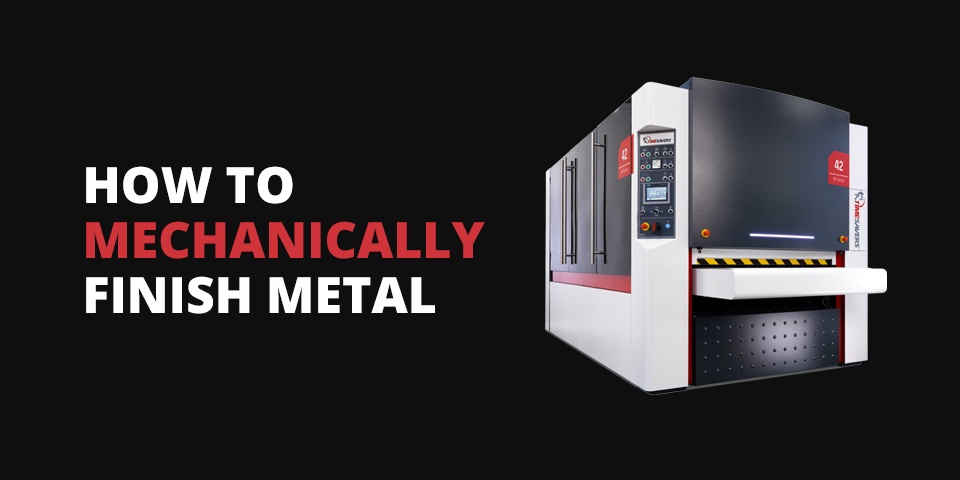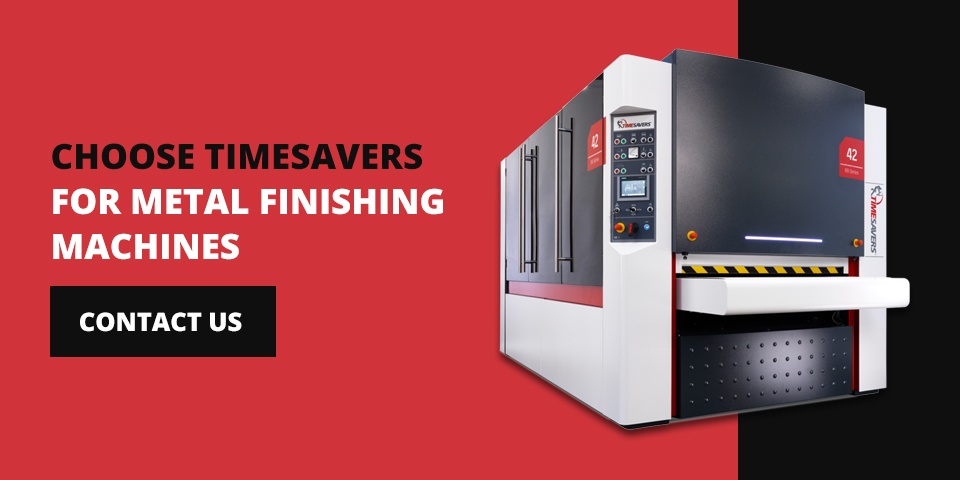How to Mechanically Finish Metal

After a piece of metal is shaped by a machining process, there’s a chance the surface will contain blemishes and sharp edges that could get in the way of the item’s intended application. By using metal finishing techniques, you can create a beautifully smooth and polished manufactured metal product. Depending on your manufacturing process, you will need to use different finishing techniques for the desired effect.
Learn more about the benefits of mechanical metal finishing and how to finish metal below.
What Is Metal Finishing?
Metal finishing is the process of treating a manufactured piece of metal so its surface changes for a specific purpose. Depending on the technique and materials used, metal finishes allow a manufacturer to add desirable characteristics to the substrate. These changes can vary from simply making the object look different to completely altering how the object functions.
Manufacturers can achieve metal finishes mechanically with specialized equipment like brushes and grinders. They can also use chemical processes to achieve specialized coatings, although the process usually begins with a mechanical approach to remove most of the imperfections in the metal.
Here are some examples of industries that use metal fabrication finishing in their manufacturing processes:
- Vehicles: The automotive industry uses metal plating techniques to protect vehicles from rust and corrosion.
- Hardware: Zinc, chrome and nickel finishes on small parts like screws and nails have various benefits, from decorative appeal to enhanced hardness.
- Electronics: Metal finishes allow manufacturers to increase or reduce electrical conductivity depending on their needs.
- Jewelry: Jewelry manufacturers use metals like palladium and rhodium to change a piece’s coloration and increase its durability.
- Home appliances: Temperature-resistant metals, like titanium, help protect wiring from intense heat.
- Aerospace: Ultra-thin layers of cadmium plating reduce corrosion in steel flight components.
The Importance of Mechanical Finishing
Before you treat the metal with chemical processes like electrocoating or apply any spray finishes, you should start with a mechanical finish. There are advantages to mechanical finishing, whether you ship the product immediately afterward or treat it further.
Here are some benefits to mechanical finishing:
- Aesthetics: Compared to a finished part from a store or on a new piece of equipment, a freshly manufactured metal part typically looks a little rough. Jagged edges, surface defects and plasma slag can give the impression of a low-quality or inferior product. By removing these blemishes, the end product looks much cleaner and more professional. Depending on the level of finish, the metal can appear opaque, glossy or even mirror-like.
- Reduced corrosion: The more porous a surface is, the more likely it is to rust. Metal surface finishing effectively reduces the amount of metal in contact with the air, which reduces the risk of corrosion.
- Change in texture: Surface roughness changes the metal’s tactile feel, which makes a big difference depending on where you apply the item. For example, a smoother kitchen surface is preferable to a rougher texture. The smooth surface is more pleasant to work on, with the added benefit of being easier to clean than a more irregular surface.
- Safety: The jagged or rough edges of a newly manufactured metal piece can be dangerous. A proper mechanical finish will smooth the edges away and protect from cuts or other injuries.
Mechanical Metal Finishing Solutions and Techniques
Manufacturers use a variety of techniques to create the perfect finish for their products. Mechanical finishing processes exclusively use machinery to smooth out imperfections in the metal and alter the finish. Here are some examples of metal surface finishing techniques:
- Deburring: When a machining process shapes a piece of metal, the end product may contain small ridges or metal protrusions. These imperfections, known as burrs, can make the product unpleasant to handle or unappealing to look at. A deburring process removes the burrs so the metal has a workable finish.
- Edge rounding: After deburring, a finished metal part may still have sharp or scalloped edges. Edge rounding, also known as edge radiusing, breaks down these edges even further so the final product is uniformly smooth and free of sharp edges.
- Heavy slag removal: Heavy slag, also known as dross or plasma slag, is an especially large burr formed when working with flame cutting or plasma cutting processes. Heavy slag removal processes can remove the dross in a single pass.
- Laser oxide removal: When using laser cutting processes, an oxide skin can form on the metal surface. Manufacturers must remove the oxide skin before any powder coatings are applied. Manufacturers can mechanically remove laser oxide with a series of steel wire brushes. The mechanical process is preferable to chemical treatments to remove laser oxide skin because it’s safer for the environment and reduces production time.
- Precision grinding: Unlike flat surface grinding, precision grinding allows the manufacturer to carve the shape of the metal. Using abrasive belts, the manufacturer can achieve a tapered surface that they can use for various applications.
Finding the Right Machine for Your Business
Your choice of finishing machine will depend on your manufacturing process. Different applications require different approaches, and it’s essential to choose the machine that aligns with the end goal for your products.
Here are some points to consider when choosing an industrial metal finishing machine:
- Previous processes: The way you manufacture your product can inform the level of care required. For example, laser cutting and plasma cutting will both require edge rounding capabilities. The laser-cut items will likely also need laser oxide removal treatment, while the plasma-cut items may have heavy slag to remove.
- Finishing goals: You might choose a machine depending on your purpose for the final product. Your goals may include rounded edges, for instance, so you could compare machines based on the minimum rounded edge radius.
- Maximum work widths: Finishing machines come in a variety of sizes depending on your needs. Working widths can be anywhere from 9 inches or smaller to 63 inches.
Choose Timesavers for Metal Finishing Machines
No matter your finishing goals for your products, Timesavers has a machine to fit your needs. We supply a wide variety of machines suitable for varying budgets and applications. From deburring to wide belt grinding, our metal finishing machines are the best in the market. And with a worldwide service and dealer network, you will always have access to support when you need it.
If you need help deciding on a machine, feel free to contact us today!

